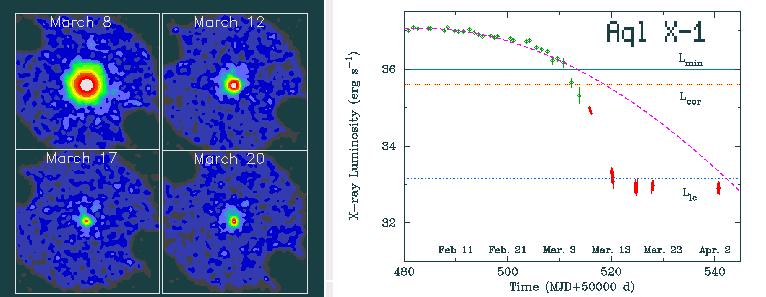
 Credit: S. Campana, Brera Observatory, Milano-Merate
Credit: S. Campana, Brera Observatory, Milano-Merate
The Fall of Aquila X-1
Objects called "Soft X-ray Transients" are composed of some type of compact
object (probably a neutron star) and some type of "normal", low mass star
(i.e. a star with a mass of some fraction of the Sun's mass). These
objects show changing levels of low-energy, or "soft", X-ray emission,
probably produced somehow by variable transfer of mass from the normal star
to the compact object. In effect the compact object "gobbles up" the
normal star, and the X-ray emission can provide the best view of how this
process occurs. But because these objects vary it's difficult to catch
them at crucial times. In February 1997 a soft X-ray transient in the
constellation of Aquila known as Aql X-1 was detected in outburst by the Rossi X-ray Timing Explorer. RXTE
followed the slow decline from X-ray maximum; but when the RXTE
observations ended the story was still not complete, since the star had not
reached its normal "quiescent" level. This important gap was filled in by
the BeppoSAX X-ray satellite, which
started to observe Aql X-1 at the
end of the RXTE observations. The image on the right shows the decline
from X-ray maximum as seen by RXTE (green points) and BeppoSAX (red
points). RXTE clearly shows a rather smooth decline though the last two
data points do not follow the smooth decline but seem fainter than
astronomers would have predicted. The BeppoSAX observations confirm the
RXTE results and show that the decline to quiescence occurs much more
rapidly than expected. The image on the left shows BeppoSAX images
detailing the change in brightness of Aql X-1 through March 1997.
Last Week *
HEA Dictionary * Archive
* Search HEAPOW
* Education
Each week the HEASARC
brings you new, exciting and beautiful images from X-ray and Gamma ray
astronomy. Check back each week and be sure to check out the HEAPOW archive!
Page Author: Dr. Michael F.
Corcoran
Last modified October 8, 2001


